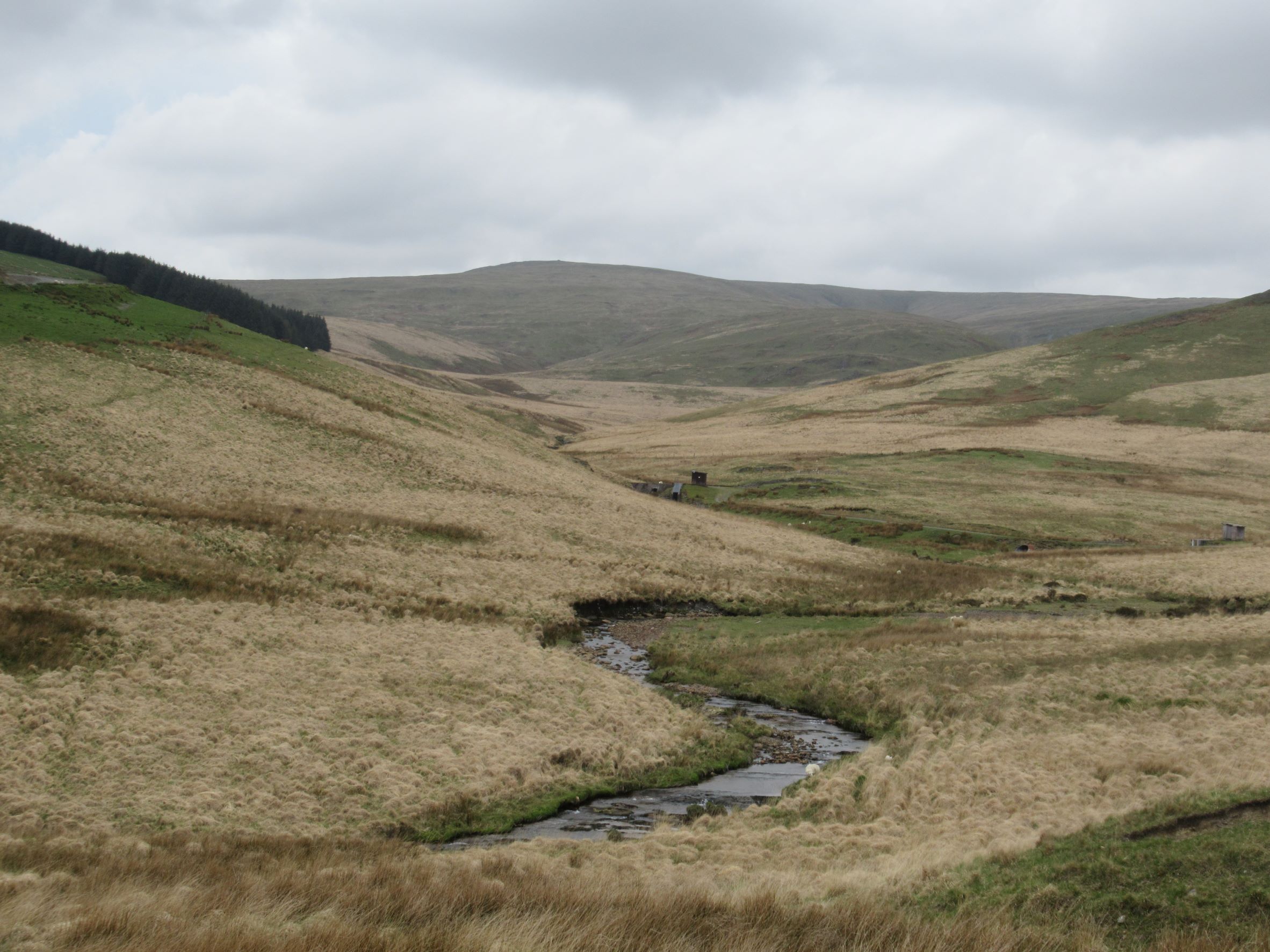We’re back to four of us today. We’ve arranged to meet Ch on the Wye bridge: he’s been staying in Clochfaen, a large house completed in 1915 by the Verney family, who invested large amounts of money into the economy and buildings of Llangurig in the late nineteenth century. Earlier the village even had a branch railway line, though only a single goods train ran on it in 1863 before it was closed.
Outside the village shop, where we buy supplies for the day, two women stop to talk. One is acting as chauffeuse for a group of walkers; the other wants to take a photo of us for the village shop’s Facebook page. A. later sends us a link: we make unlikely celebrities.
Most strenuous diversions on the Walk seem designed to put off the moment of arrival at the destination, but today the deviation comes right at the start: a climb up a ridge, Esgair Llwyn-gwyn. The path goes past a farm, Llwyn-gwyn, with an array of redundant David Brown tractors and other farmyard antiques. The ridge is windy – it’s a darker and much cooler day than yesterday – and it’s a relief to drop back down to the river. Everything here seems in poor condition: the stiles and signposts are rickety with age, and we pass frequent wrecked buildings. Where there is life, it can be unusual. Tanybryn is the place to go if you want to acquire Laakso Elkhounds. It also provides a wayside Buddha, with a place for donated coins (A. claims this is unorthodox). Pengeulan is an ancient farmhouse whose roof is completely covered with solar panels.
There are fewer flowers at this altitude, but the Wye birds are as active as ever. We hear, and sometimes see, skylarks on most of the hills, and as the moorland begins swifts dart and circle. On several occasions, including in the forest, we hear cuckoos – more than I’ve heard in a single day for many years.
The path now leads through a wood, with delicate silver birches on either side, before descending to the riverside. At Tŷ Mawr the guidebook tells us to ‘go around’ the farm buildings, without saying which way. We select the wrong way, and have to struggle to regain the path, before a chug up towards a hill topped with a mohican-style haircut of conifers. Then down to the river once more, past a horse cooling its legs in the water and a curved metal bridge. The path divides into two options, high-level and low-level. We conduct a poll, and I’m outvoted, so we take the river option. Again we go wrong, and instead of hugging the river we blunder into a farm. The farmer stops us and, politely but firmly, informs us we’re trespassing. Back on track, we realise we’re now on the high-level path.
At Penrhydgaled we cross the river and the road and find ourselves in a quite different landscape, wild, barren upland. We stop at an untidy collection of temporary buildings calling itself the Sweet Lamb Adventure Rally Bike Academy. Its business is motorbike training, but there’s no one about, just an array of CCTV cameras. We agree it’s sinister enough to be a location for an episode of Hinterland, and challenge the cameras by sitting down at a table to eat our sandwiches. A broad unmetalled track now climbs up into the mountains, for several miles. It makes a tough surface for the feet, but the compensation is wider and wider views of the hills. This land is not called the Green Desert for nothing: long, treeless ridges divided by deep clefts, and, in the middle, the Wye, now easily jumpable. It winds down, collecting small tributaries, from the grey, unimpressive bulk of Pumlumon in the distance.
Past another jumble of Sweet Lamb buildings, like a location for a western film, and then a lead mine, Nant Iago, abandoned in the early twentieth century. Its spoil heaps spill down the slope and bits of machinery litter the mine entrance. We imagine how hard and dangerous the lives of the nineteenth-century lead miners must have been.
We’ve left the Wye behind by now. A spur path invites us to walk to a viewing point of its source, close to the summit of Pumlumon (it doesn’t actually go to the source itself). But we press on. As we come to the entrance to the huge Hafren Forest a burst of wind in the conifers makes a sound like a rushing river. It’s quieter inside the forest. We follow the track used by rally cars in season, winding between the conifers, but the path suddenly breaks away, to follow Afon Hore, this time through deciduous trees.
After a mile or two, the stream, discoloured in patches by the metal mining, joins the infant river Severn, which also springs from the slopes of Pumlumon. Two wooden picnic tables have been uprooted and hurled into the water: we wonder what strange prejudice might lie behind such activity. Now we follow the Severn down to our final and disappointingly mundane destination, a car park at Rhyd-y-Benwch. Soon A2 arrives by car with refreshments, and takes A home. Our promised taxi appears, and takes us, via the delightful young Severn valley and the town of Llanidloes, back to Llangurig.
And so ends a journey, first begun at Chepstow in September 2021, that moves slowly from lowland affluence in Monmouthshire and Herefordshire to the bleakest, most austere landscapes in Wales. We agree that the Wye Valley Walk must be the finest of all the medium-distance paths in Wales.








Leave a Reply